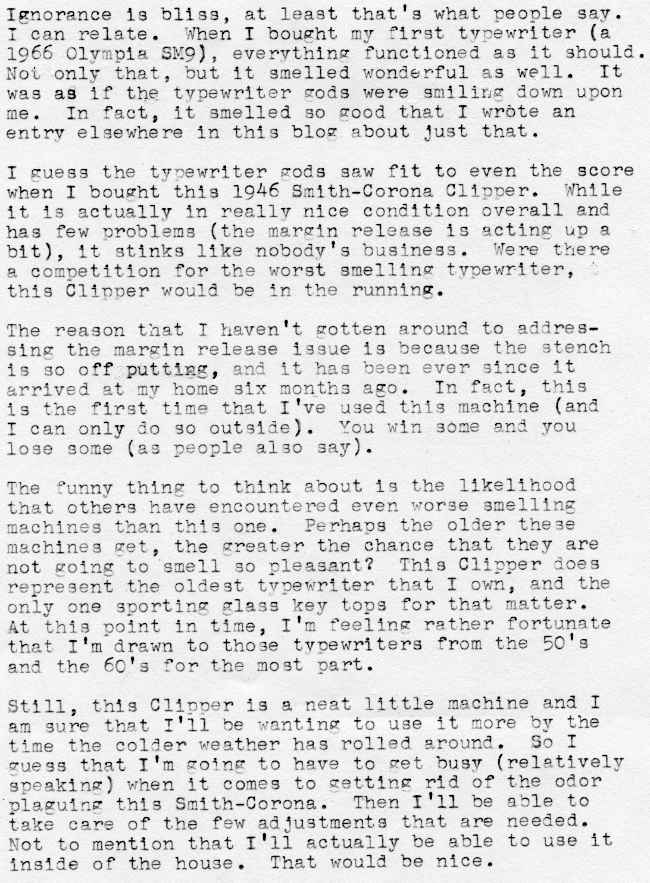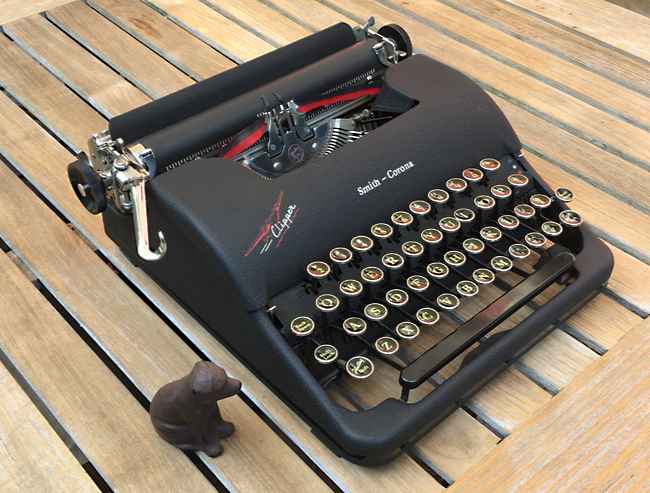
Ignorance is bliss, at least that’s what people say. I can relate. When I bought my first typewriter (a 1966 Olympia SM9) , everything functioned as it should. Not only that but it smelled wonderful as well. It was as if the tvoewriter gods were smiling down upon me. In fact, it smelled so good that I wrote an entry elsewhere in this blog about just that.
I guess the typewriter gods saw fit to even the score when I bought this 1946 Smith-Corona Clipper. While it is actually in really nice condition overall and has few problems (the margin release is acting up a bit), it stinks like nobody’s business. Were there a competition for the worst smelling typewriter, this Clipper would be in the running.
The reason that I haven’t gotten around to addressing the margin release issue is because the stench is so off putting, and it has been ever since it arrived at my home six months ago. In fact, this is the first time that I’ve used this machine (and I can only do so outside). You win some and you lose some (as people also say).
The funny thing to think about is the likelihood that others have encountered even worse smelling machines than this one. Perhaps the older these machines get, the greater the chance that they are not going to smell so pleasant? This Clipper does represent the oldest typewriter that I own, and the only one sporting glass key tops for that matter. At this point in time I’m feeling rather fortunate in that I’m drawn to those typewriters from the 50’s and the 60’s for the most part.
Still, this Clipper is a neat little machine and I am sure that I’ll be wanting to use it more by the time the colder weather has rolled around. So I guess that I’m sons to have to get hush (relatively speaking) when it comes to setting rid of the odor plaguing this Sm1th~Corona. Then I’ll be able to take care of the few adjustments that are needed. Not to mention that I’ll actually be able to use it inside of the house. That would be nice.
AFTERTHOUGHTS: While this 1946 machine might be the oldest typewriter I own, it’s interesting to think that many typewriter enthusiasts are only drawn to machines that are older than this. It’s actually pretty cool to think about just how long of a run typewriters have enjoyed. This Clipper was one of only two typewriters that I purchased via Goodwill’s website. Almost no attention was paid to protecting the typewriters for shipment in either case (no pun intended), yet miraculously, both typewriters arrived intact.


Oh, stinky machines are a challenge. I generally remove the housing when possible and leave them insides facing the sun and let the entire machine sit in the sun. sometimes it takes a few days. Florian (maschinengeschrieben) used to fill them with fresh lavender, put them back in the case and let them sit until they smelled fresh. I tried dusting the insides of the housings with baking soda and letting them sit for a few days. That did not seem to work as good as the sun.
So what’s it smell like? I had a similar ’45 Sterling that had a strong mildewy/moldy smell. I put a pine tree freshener in the case with it, but the smell never went away in the two years before I passed it on for unrelated reasons.
Speaking for myself, I’d rather have that Clipper than any number of ’50s and ’60s typewriters–that’s when typewriters started to lose their pizzazz. If the odor were really unbearable, I’d try Bill M’s sun method–we’ve certainly had enough of that here lately–and if that didn’t help, I’d remove and replace all the felt. It’s not the metal parts that smell.
Hi Guth
The first thing to do is to let the machine air for a couple of days, then see if you can determine where the smell is actually coming from. The inside of the case can often get a mildew smell, the crinkle paint on these machines tend to trap tar and nicotine from cigarettes and the sound deadening felt inside the ribbon cover and body work will often smell musty.
The inside of the case will usually respond to an application of mold and mildew spray followed a few days later with a wipe down using a damp cloth and a mild bleach solution. A couple of applications of Febreze fabric freshener will usually neutralize the smell. The crinkle paint cleans up nicely with an application of Scrubbing Bubbles bathroom cleaner, a gentle scrub with a soft bristled brush and a rinse off with hot water. Just be vary careful around the water-slide transfer of the seaplane and other lettering.
Although I’ve never come across it myself, I have heard of old machinery stinking because it was lubricated with poor quality whale oil which can go rancid. From what I understand, sperm whale oil was the fine machinery oil of choice as it was clear and didn’t smell. Whether this machine is old enough to have been lubricated with whale oil, I don’t know, but it’s a thought. All the best,
William
I have a a clipper as well. I recently saved it from the dump, case and all, it’s only missing a spring and it’s greasy as heck but what’s worse it smells so bad, that it gave me a sore throat while I was opening it up, smells like cat urine I think. I just wish there was some more specific tutorials for this model so I can clean it thoroughly.
Keep the faith that you’ll be able to overcome the stench. Fortunately it doesn’t cost anything to leave a typewriter out in the sun (once such weather arrives wherever you are located), which is one of the more effective ways to combat offensive odors. If your Clipper appears the same as mine, any tutorial covering cleaning of the 4-Series Smith-Corona machines should be helpful. If yours is a later (i.e. newer) model, then the same would go for tutorials covering cleaning of the 5-Series machines. Keep searching as you’re bound to find something helpful. I’m guessing that Phoenix Typewriter’s videos out on YouTube might contain some of the info that you’re looking for.